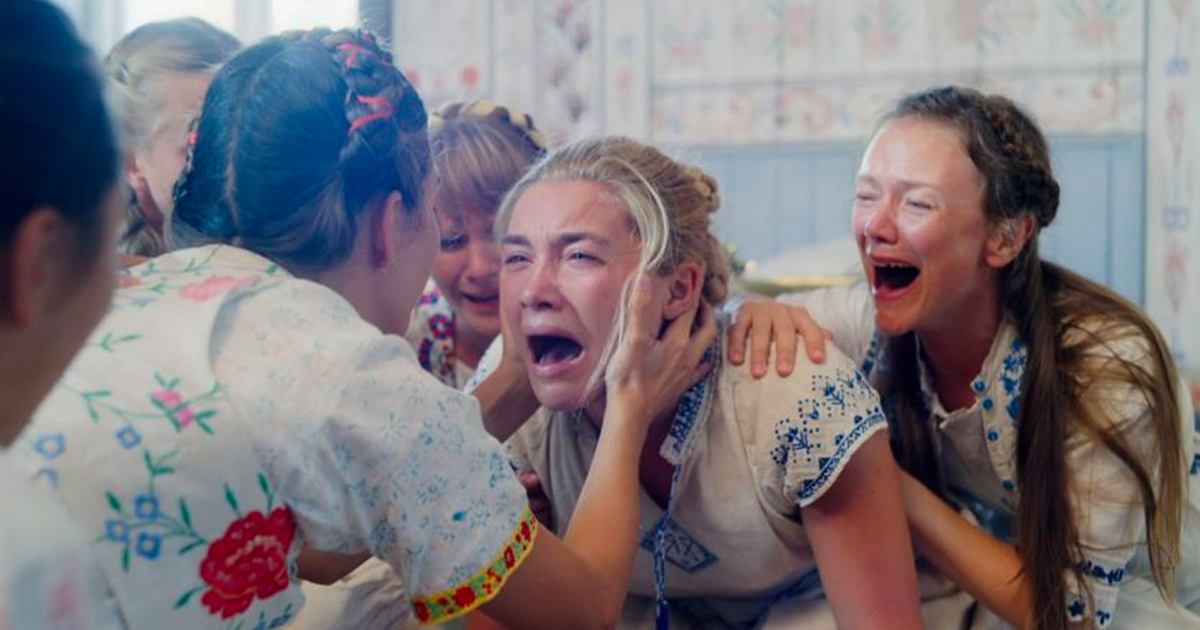
Ari Aster’s debut feature-length film “Hereditary” shocked audiences with a story about family’s unraveling after the death of a loved one. His follow-up “Midsommar” is again about death and its effects on people, but instead of damaging a relationship, it appears to extend it.
The story centers around Dani (Florence Pugh, a grad student whose broken relationship with Christian (Jack Reynour), looks to be heading towards its premature conclusion. When a horrific family tragedy blindsides Dani it leaves Christian feeling too guilty to bring things to what had seemed like an inevitable end. Instead of going their separate ways, they ultimately end staying together longer to join their friends on a trip to Swedish commune to take part in the midsummer celebration.
The commune is a tranquil setting with full of picturesque, lush fields of green, participants wearing long flowing natural hair, embroidered white ceremonial garbs, historical tapestries full of colorful imagery, and bright blue skies. Everything about the place exudes a feeling of peace and harmony, but as is often found the things that scare us, there is more going on just below the surface. For some reason, this level of amicability carries with it an element of creepiness to it. This place is no exception. When someone/something maintains an elevated level of calm, it is just hard to trust. Perhaps it is because most people’s lives’ are a series of ups and downs – without one or the other, it is unnatural.
Soon, the group of friends is exposed to some of the commune’s negative aspects as they are forced to partake in one of the festival’s odd events. It starts in a positive fashion, but shockingly, the ritual ends with a pair of elderly group members’ lives coming to a gruesome, violent ending. While most of the outsiders are so upset they have to turn away from the gruesome sight, the community members, both young and old, continue to watch with smiles of contentment on their faces. There is no mistaking this was no accident. Dani and her friends are in for a much darker experience than originally promised.
The film is a slow burn and even as the ominous aspects of this society are revealed, the pace never rises above to slow-speed chase. If you are looking for flat out scares, this is not the film for you. It succeeds at delivering a level of eeriness throughout, reinforced by discussions of prophecies, hallucinogenic teas, “religious” rituals, and other suspicious reveals that add to the ambient creepiness.
As the film passed halfway point I felt as if had most of it figured out. And, disappointingly, I was not wrong. This may be due to my impressive intellect or maybe my world-class sleuthing abilities, but more likely to Aster’s decision to cloak much of the cult’s rituals in hollow ambiguity. The symbolism behind the camp reinforced by the actions of its members hinted at, but the details all rather vague. Sometimes this approach works, leading to a terrifying sense of impending doom that ramps up into pure terror. In those cases, it often better to just get wrapped up in the menace instead of focusing too much on what generated the fear. With the deliberate creeping pace of “Midsommar,” it is kind of difficult to not want to know more…. the more never comes.
Is this a case of style over substance? Is it less is more? Or is it both? Maybe the best way to describe it is the parts are greater than the whole. There’s the strong, mesmerizing performance by Pugh which shows why she is a rising star. At the same time, neither her character, Dani, nor Christain is likable enough to truly care about their fates. The “cult” as a whole remains an enigma that continuously presenting more and more mysteries and intrigue, but all their motives remain vague. Aster has a firm grasp on the visual style, creating a dreamlike world with meticulously crafted costumes and props that feel authentic to the story. The explicit visual shocks moments and horror components will hold some interest, especially set against the beauty of the tranquil, secretive environment. The colorful palette of floral colors, earth tones, and bright blue skies are almost teasing the characters while juxtaposed against a tone that continues to grow darker as the film carries on.
Any way you look at it, the film is an overlong, intriguing, ominous mood piece. While it is aesthetically pleasing, as a whole, it does not earn the lengthy visit. There is appears to be much to chew on but in reality, it is a facade that doesn’t justify the effort. If you are thinking about taking a trip to the commune, go in with reasonable expectations, immerse yourself in the ambiance, and don’t plan on any rewarding excursions. By doing so, perhaps you’ll enjoy your stay more so than I did.
Quick Scan
While visually stunning with an ominous tone “Midsommar” ends up feeling more hollow than horrifying.

